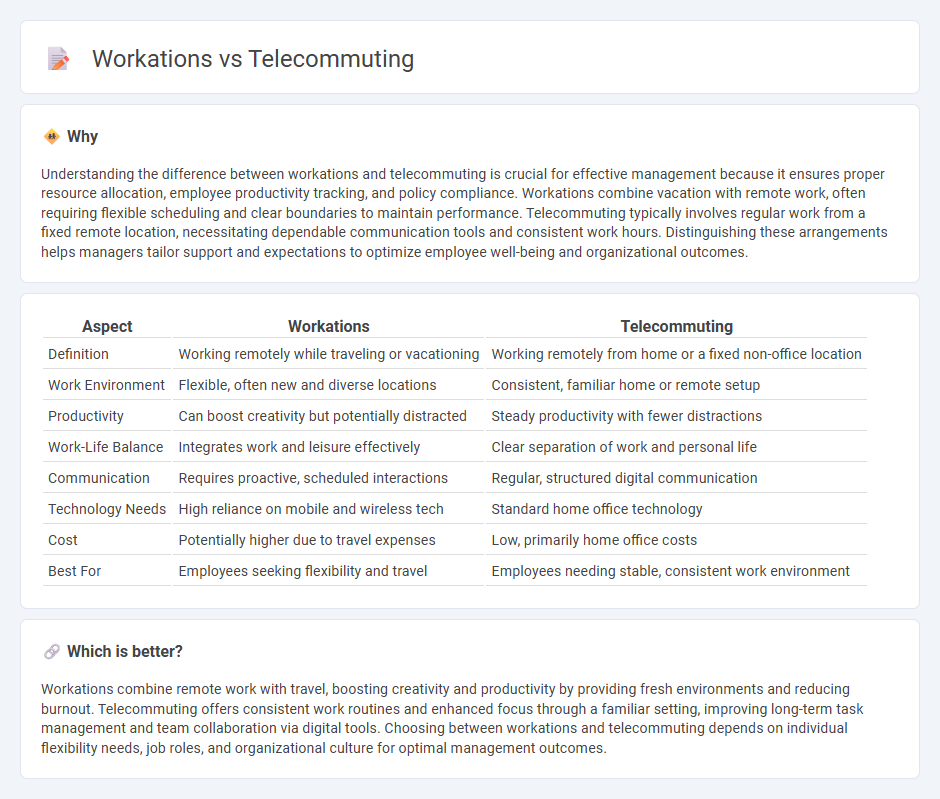
Workations combine remote work with travel, allowing employees to maintain productivity while exploring new environments, enhancing creativity and motivation. Telecommuting involves working from a consistent remote location, typically home, offering flexibility and reduced commuting time but limited change in surroundings. Explore the benefits and challenges of both models to optimize your management strategy.
Why it is important
Understanding the difference between workations and telecommuting is crucial for effective management because it ensures proper resource allocation, employee productivity tracking, and policy compliance. Workations combine vacation with remote work, often requiring flexible scheduling and clear boundaries to maintain performance. Telecommuting typically involves regular work from a fixed remote location, necessitating dependable communication tools and consistent work hours. Distinguishing these arrangements helps managers tailor support and expectations to optimize employee well-being and organizational outcomes.
Comparison Table
| Aspect | Workations | Telecommuting |
|---|---|---|
| Definition | Working remotely while traveling or vacationing | Working remotely from home or a fixed non-office location |
| Work Environment | Flexible, often new and diverse locations | Consistent, familiar home or remote setup |
| Productivity | Can boost creativity but potentially distracted | Steady productivity with fewer distractions |
| Work-Life Balance | Integrates work and leisure effectively | Clear separation of work and personal life |
| Communication | Requires proactive, scheduled interactions | Regular, structured digital communication |
| Technology Needs | High reliance on mobile and wireless tech | Standard home office technology |
| Cost | Potentially higher due to travel expenses | Low, primarily home office costs |
| Best For | Employees seeking flexibility and travel | Employees needing stable, consistent work environment |
Which is better?
Workations combine remote work with travel, boosting creativity and productivity by providing fresh environments and reducing burnout. Telecommuting offers consistent work routines and enhanced focus through a familiar setting, improving long-term task management and team collaboration via digital tools. Choosing between workations and telecommuting depends on individual flexibility needs, job roles, and organizational culture for optimal management outcomes.
Connection
Workations and telecommuting both leverage remote work technology to enhance employee flexibility and productivity outside traditional office settings. These practices reduce commuting time and enable management to support work-life balance while maintaining organizational efficiency. The integration of cloud-based tools and digital communication platforms facilitates seamless collaboration between remote and on-site teams.
Key Terms
Remote Work
Telecommuting involves working remotely from a fixed location such as home, allowing employees to maintain a consistent workspace while leveraging digital communication tools. Workations blend remote work with vacation, enabling professionals to perform job tasks from travel destinations, balancing productivity and leisure. Explore how these remote work models impact employee performance and company culture.
Flexibility
Telecommuting offers employees the flexibility to work remotely from their chosen location, allowing for a consistent work environment and schedule. Workations combine work and vacation by enabling individuals to perform their job duties while enjoying new destinations, providing a dynamic balance between productivity and leisure. Explore more about how flexibility in telecommuting and workations can enhance work-life integration and employee satisfaction.
Work-Life Balance
Telecommuting enhances work-life balance by allowing employees to perform their tasks remotely, reducing commuting stress and fostering flexibility in managing personal and professional responsibilities. Workations blend work with short trips, offering a change of scenery that can boost creativity and mental well-being while maintaining productivity. Explore how both telecommuting and workations can be tailored to optimize your work-life balance effectively.
Source and External Links
What Is Telecommuting in Today's Work Environment? - This article discusses how telecommuting has become a mainstream method of working, especially since the COVID-19 pandemic, and its continued impact on the modern workplace.
What is telecommuting? | Definition from TechTarget - Telecommuting allows employees to complete work assignments from outside the traditional workplace using telecommunications tools, available in various arrangements such as full-time, part-time, and temporary.
What is telecommuting? - WalkMe - This guide covers the basics of telecommuting, including its definition, benefits, and real-world examples, highlighting its importance in the contemporary digitalized workplace.
 dowidth.com
dowidth.com